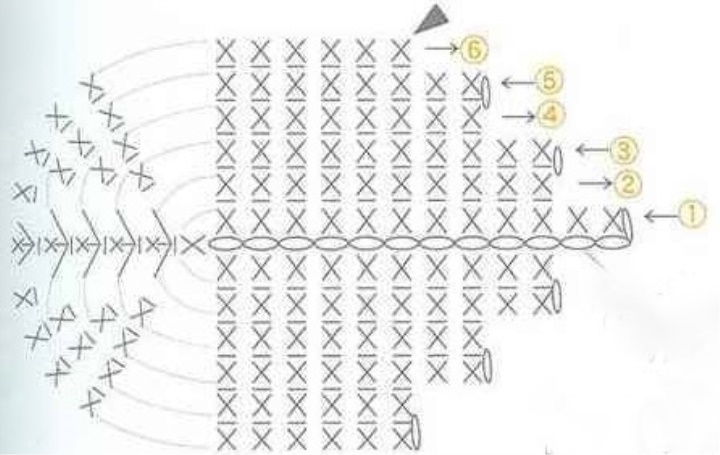
The leaf is knitted from the crochets, connected behind the back wall, so veins are formed. We collect 13 VP. Starting from the 2nd from the end of the chain, we knit 12 sbn. And further according to the scheme ...
Torso:
1 row-- out of 2 VP, we knit 6 sbn (6).
2 row-- from each loop- 2 sbn (12).
3 row-- 1 sbn, in the next loop - 2 sbn (18).
4 row-- 2 sbn, in the next .- 2 sbn (24).
5 row-- 3 sbn, in the next .- 2 sbn (30).
6 row-- 4 sbn, in the next .- 2 sbn (36).
7 row-- 5 sbn, in the next .- 2 sbn (42).
8 a row-- 6 sbn, in next .- 2sbn (48).
9 row-- 7 sbn, in the next .- 2 sbn (54).
10-19 rows-- 54 sat (54).
from the 20th row we decrease:
20 row-- 6 sbn, 2 together sbn (48).
21 a row - 5 sbn, 2 together sbn (42).
22 row-- 4 sbn, 2 together sbn (36).
23 row-- 3 sbn, 2 together sbn (30).
24 row-- 30b (30).
25 row-- 2 sbn, 2 sbn together (24).
26 row-- 2sbn, 2 together sbn. We stuff the body with padding polyester.
27 row-- 1 sbn, 2 sbn together
28 row-- we connect all loops in pairs and close them.
Pants:
We knit, as the body, but only up to the 17th row.
18 and 19 rows, change the color to another, in order to isolate the belt and knit these rows behind the back wall.
You can not make the pants separately, and immediately change the colors until fit torso. That is, first choose the color of the pants, knit up to the 17th row inclusive, then change the color and 2 rows of the knit belt, and then, from the 20th row, knit the selected color of the entire elephant (I have white). And if we knit the pants separately and then we stretch them on the body, then we know that we have a little secret pocket on the elephant. Then just knit a strap on the pants and sew it and buttons.
Feet:
White thread:
1 row-- out of 2 w, we knit 6 sbn (6).
2 row-- 2 sbn in each loop (12).
3 row-- 1 sbn, in the next .- 2 sbn (18).
4 row-- 18 sbn behind the back wall. (18).
Change the color to green (leg):
5 row-- 18 sbn behind the back wall. (18).
6-10 rows-- usually 18 sat. (18).
Stuff the padding polyester and sew, without closing.
Pens:
White thread:
1 row-- out of 2 w, we knit 6 sbn (6).
2 row-- 2 sbn in each loop (12).
3 row-- 1 sbn, in the next .- 2 sbn (18).
4-9 rows-- 18 sat (18).
10 row-- we turn down. 1 UBN, 2 UBB together (12).
11 row-- 12 sbn. Stuff with padding polyester. (12).
12 row-- all loops in pairs 2 together together (6)
13 row-- lower loops and close.
Tail:
We insert the wire into the pants (so that the elephant can sit leaning on the tail), fasten it and tie it with a white thread with a single crochet. At the end we make a couple of elongated loops.
Fishing rod:
There can not do without glue.
I take a wooden skewer (probably you can use wooden or plastic toothpicks). I cut off - break off a piece equal to the length of the fishing rod, at your discretion. One tip is moistened with transparent glue (such as "Moment-gel") and I wind a "line" on it - ordinary sewing threads. I'm waiting for it to dry up. Then I take the tip of the thread, 2 smallest beads or beads and sew the fishing line to the fish, at the same time sewing eyes on both sides.
Now I sew this fishing pole to the elephant's paw. To be sure, a little glue with the same glue.
Fish:
I type 7 VP. In the second loop I knit 1 sbn. Further: 1 double crochet, 1 double crochet, 1 double crochet, 1 non-crocheted column. In the last loop I knit 5 columns with 3 naquids (depending on the length and width of the desired fish and its tail). I cut short the thread, which should be enough to bring it to the 7th loop of the fish and tie a knot there around the tail, and also to hide the tip.
Add a hat and a backpack. The backpack is removed, and the hat is sewn to the head, so as not to fall and cover the hairstyle. And you can come up with your accessories for the elephant-fisherman :)